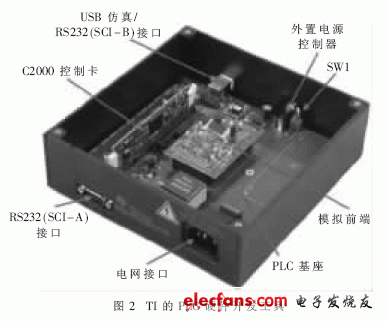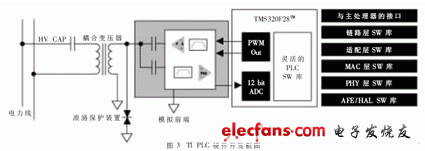PLC technology can be generally divided into two categories: broadband PLC and narrowband PLC. The former is suitable for high-speed WAN connections such as the Internet. It adopts OFDM modulation. The current standards established by the HomePlug Alliance have become the international mainstream; the latter is suitable for occasions that focus on low cost, high reliability, and only require narrowband control or low bandwidth data collection. At present, the PRIME and G3 standards for NB PLC have entered the actual deployment stage; IEEE P1901.2 and ITU-T G.hnem two international standards are about to be completed. The frequency band of NB PLC is designated and divided by the frequency band management agencies of various countries. In China, EPRI prefers to use the 3 kHz to 90 kHz frequency band; there is no regulation on how to use the single frequency band from 3 kHz to 500 kHz. PLC application and its advantages PLC can transmit data on the power line, which provides a cost-effective communication method for many application fields. Because there is no need to install additional cables directly on the interconnected equipment, PLC significantly reduces system cost, improves system reliability, and enables effective communication. PLC technology can use the existing power line infrastructure, which makes it occupy an advantageous technical position in the field of smart grid (Smart Grid). In the field of smart meters, NB PLC provides a robust alternative to wireless communication that can meet the requirements of bandwidth, power consumption and cost. NB PLC has different standards, and its data rate also ranges from 1.2 Kb / s to a maximum of 128 Kb / s, which can meet the bandwidth requirements of data acquisition, lighting control, home automation and other applications. In this way, NB PLC will be a very attractive technology that can be used as a smart grid communication infrastructure. Similarly, PLC technology makes it possible to achieve more intelligent management in systems such as lighting control, heating and air conditioning systems for homes and buildings, and safety and other systems. As long as the system is connected to the power supply network, its efficiency and operating conditions can be intelligently managed and improved. Figure 1 shows the application areas where PLC solutions can be applied, including smart grid, street lighting, smart meters, solar energy, wind energy, home automation, etc. Figure 1 Application areas of PLC solutions Challenges facing PLC There are many challenges in developing an effective PLC, for example, the inherent noise of the power line; a robust architecture is required to ensure data reliability; each application and operating environment is different, and developers need to optimize the design to adapt to various factors. Too much fixed function of PLC will limit its application field; moreover, because the PLC standard has not been fully determined and is still evolving, this is also a risky design strategy. Developers need a flexible platform, which will be able to optimize the design for the specific needs of each application, while also being able to adapt to new standards and emerging market opportunities. In this way, PLC's intellectual property can be reused in a variety of applications, which can accelerate the development process and shorten the time to market when responding to expanding market opportunities. The modular design of hardware and software is the key to the flexibility of the development platform. By decomposing a complex PLC system into independent subsystems, developers can be allowed to change certain aspects of the design without completely redesigning the entire system, such as modulation or communication protocols. (1) Modulation method: The flexibility of the hardware layer allows developers to implement the most effective modulation method for a specific application. For example, narrowband communication can use extended frequency shift keying (S-FSK) and orthogonal frequency division multiplexing (OFDM). (2) Communication protocol: In order to achieve interoperability, devices must follow specific protocol standards. On a flexible platform, developers can easily implement all popular PLC standards, such as SFSK (IEC61334), PRIME, and G3; at the same time, it can keep the device updated with the standard speech. In addition, since there is no need to completely redesign the hardware and firmware, the process of migrating the design to a new application or protocol will become simple. (3) Follow local regulations: The strong support of various countries for "green electronic products" has spawned communication regulations (CENELEC, FCC, ARIB, etc.), which will bring smart grid (Smart Grid) and other PLC-based applications To have a profound impact. Developers need tools to ensure that devices meet regulatory requirements, and help them pass tests as quickly as possible to obtain approval to get products to market as soon as possible. Design of TI NB PLC solution TI's NB PLC solution eliminates the need for developers to care about the complexity of their designs and lowers the threshold for PLCs in many industrial applications. The efficiency and flexibility of TI NB PLC solutions enable customers to quickly differentiate and customize designs for specific application needs. Based on the unique modular hardware architecture and flexible software framework, TI's PLC solution is currently the industry's only technology that can support multiple standards and modulation methods on a single platform. Modularity of PLC software TI's PLC software (plcSUITETM) provides a powerful framework that enables developers to quickly develop PLCs, implement and test their robustness. The flexibility of the software platform allows developers to separate modulation implementation, protocol design, and application development. Developers can use the graphical interface (GUI) to easily visualize and adjust key PLC performance parameters. TI's NB PLC solution can support multiple modulation methods and protocol standards on the same hardware platform. Modularization of PLC hardware TI's flexible NB PLC hardware platform makes development easier. As shown in Figure 2, the PLC hardware development tool consists of an analog front end (AFE), an MCU card, and a docking station (Docking Station). The modular design of the development platform allows developers to easily adjust the hardware of the system to meet different PLC communication indicators. For example, in addition to supporting PRIME and G3 standards, TI also supports proprietary, fully programmable, OFDM-based systems through the FlexOFDMTM library; developers can optimize performance and stability for specific operating environments and further improve efficiency. If necessary, the OFDM implementation can be quickly customized by configuring the operating frequency band and the frequency of data transmission. These improvements can be independent of protocol and application layer software. Once the design and verification are completed, developers can reduce hardware costs by integrating various modules into a single hardware board (SOM). As shown in Figure 3, the core of the TI NB PLC system is the analog front end including the coupling circuit and the processor for digital modulation and network implementation. The processor mainly implements signal processing such as modulation and demodulation, media access control (MAC), network layer processing (routing, IPV6, etc.) and application layer implementation. The memory and computing power of the processor determine the signal bandwidth that can be processed and the data rate that can be achieved. Dog Trainer,Patpet Dog Training Collar,Petainer Dog Training Collar,Pet Resolve Dog Training Collar Elite-tek Electronics Ltd , https://www.aetertek.ca

